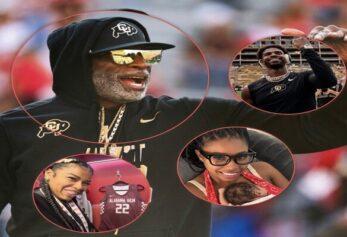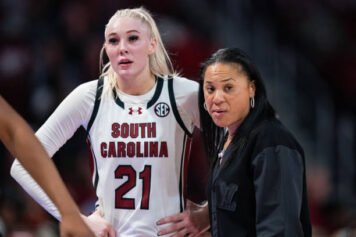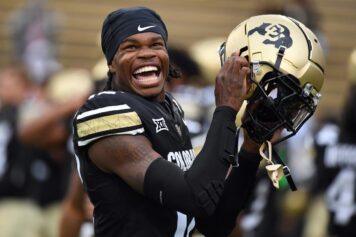In 2006, former Ohio State star running back Maurice Clarett was arrested in Columbus. Inside Clarett’s vehicle, officers found a hatchet, a loaded AK-47 variant rifle and three other loaded pistols along with an open bottle of Grey Goose vodka.
Just four years earlier, Clarett was a huge college star leading the Buckeyes to a Fiesta Bowl and national championship at age 19. A feeling of invincibility – no doubt influenced by tremendous media hype – and personal demons led Clarett to multiple arrests, dropping out of school, losing an NFL career and doing a bid.
At Ohio State – a Big Ten university where 52.9 percent of the players on the men’s football and basketball teams are black, but just 2.7 percent of the undergraduate population is black – Clarett was sheltered from the student body, stuck in a football capsule and socially stunted by his standing as a superstar male black student-athlete. When football was taken from his life and he had to deal with the harsh realities of the world, he spiraled out of control. With sports being the center of his college universe, Clarett spent little time talking with professors, studying and participating in clubs and other non-football related activities – essential pieces to post-college success for students of any race. Faculty, administrators, teachers, family and coaches spent even less time encouraging him to embrace his entire college experience.
Major universities often act as high performance meat grinders, chewing up and spitting out droves of black-male student athletes. It is culturally understood within the college community that, for black male student-athletes, sports is the first option, and few go against that philosophical grain.
While other students are enjoying a diverse plate of college activities, stimulating academics and developing sound social habits, the black male student-athlete is often lost on a field of burden and confusion with no support systems in place.
Dr. Collin D. Williams Jr., one of the authors of a recent study, “Black Male Student –Athletes and Racial Inequities in NCAA Division I College Sports,” says stories like Clarett’s are typical of the exploitation of black male student- athletes by major universities. “While much research does substantiate the lack of Black men academically prepared for college success,” Williams said, “it also speaks of the flawed ways in which colleges and universities reap enormous nancial benets at the expense of Black male student-athletes and inadequately prepare them for academic success."
The same university an athlete turns his head into mush for, possibly leading to mental disorders, doesn’t fund the player’s post-college medical needs or help them transition to life after sports.
“Ask yourself this,” Williams said, “Do colleges really expect to graduate students who, were it not for their athletic ability, did not stand a chance at gaining admission?”
Like many top athletes, Clarett’s gridiron skills generated millions of dollars for Ohio State. In return, they gave him a free education. Unfortunately, the quality of that educational experience is questionable for many black male student-athletes, who seem like victims of callous exploitation by the NCAA.
The order of operations at the universities featured in the study (which reflects the academic terms from 2007 through 2010) suggests most black male students-athletes are no more than hired guns, guising as students.
“In the case of black male athletes ,” says Williams, “they are socialized to value sports over academics at a young age. Young black men’s aspirations to play professional sports are shaped largely, though not entirely, by television and other forms of media. It seems to be the case that in lower income families with less knowledge of and about college, these popularized notions of professional athletics are not balanced with realistic depictions of what happens.”
This warped value-system, combined with a lack of enriched support systems, leaves many black-male student athletes less prepared to deal with the rigors of college than their non-athlete peers.
Williams and Horatio W. Blackman, research assistants at the Penn Center, along with lead author Harper, provided data from a four-year study of athletes from 76 colleges and universities that comprise the ACC, Big East, Big Ten, Big 12, Pac 12 and SEC.
The study found that black men made up just 2.8 percent of full-time, degree-seeking undergraduate students, but an overrepresented 57.1 percent of the football team members and 64.3 percent of male basketball players. The study identified dozens of institutions in Division I, such as Marquette University (77 percent) and the University of Miami (72.4 percent) where more than two-thirds of the black undergraduate men on the campus were athletes and some schools where more than half were athletes.
More alarming, 49.8 percent of black male student-athletes at these schools don’t graduate within six years, and 96.1 percent of these schools graduated African-American male students at rates lower than student–athletes overall.
The NCAA has often deflected the blame with excuses like the “talent pool” is shallow for prospective undergraduate black male students, and many are just not prepared for the rigors of college. Collins isn’t buying it.
It doesn’t make sense that the NCAA, a genius at marketing black male student-athletes, is a failure at graduating them.
The lack of preparedness and disengagement exhibited by the study’s black male student-athletes can be found at the high school level as well.
According to a report from the Schott Foundation for Public Education, only 47 percent of black male students graduated from high school in 2008 with peers in their entering class. They were lacking in the same vital areas as many black-student athletes; effective study habits, poor time management, identity conflicts that stunt academic achievement and ability to offset racial stereotypes.
Williams says the parents, teachers and coaches have to take a hit too. Some parents are so tempted by the lure of a pro payout that academic development is sacrificed for athletic advancement.
“In addition to asking 'how many of your former players have gone to the league,'” Williams added, “it is important for prospective student-athletes and those who support them to pose a more expansive set of questions to coaches during the college recruitment process: What is the graduation rate for black men on your team? Besides the few who got drafted, what are recent black male graduates doing? Will you support my interest in spending a semester abroad and doing a summer internship in my eld? How many players on your team studied abroad or did internships in their fields this past school year? What will happen to me if I don’t get drafted? How prepared will I be for a career in my eld? Give me specic examples of ways you encourage academic success and the holistic development of your players."
These types of questions are important to deading stereotypical beliefs about the importance of education to black male student-athletes and their families. It also humanizes the recruit to the coaches – whom the study finds often selfishly discourages black male student athletes from enjoying other aspects of campus life.
Winning college coaches get paid big-money, enjoy sneaker contracts, TV shows and advertising deals. The high-stakes DI sports atmosphere makes these coaches extra protective of “their” investments. Any activity outside of football is considered a distraction for the player. For changes to occur, the study says coaches must be departmental agents who are rewarded for winning games and achieving equity in student-athlete success.
The prevailing philosophy of “win-first and generate money now,” which exists at these universities doesn’t help either.
Williams offered an anecdote after interviewing a faculty member at one such institution about the takeaways from the research he’d been conducting on the school’s basketball and football team.
“I asked said researcher to hypothetically answer the question, how would he begin to solve these sorts of issues at his institution if he were given the position of athletic director,” Williams said. “ He giggled and responded, ‘I wouldn’t take it,’ despite the current athletic director at his institution having a seven-figure salary. As an academic at a school where the overwhelming priority is on fielding winning teams and producing revenue, academics are an elided concern for some stakeholders. Schools, like the 76 on this study, have histories so entrenched in legacies of winning, that he isn’t sure much could be done.”
The NCAA claims things are being done and the study doesn’t reflect the institutions that are currently working to improve their athlete’s academic success and recruit more minority non-athletes.
“In the years since the data was compiled, our athletics Academic Support Program has doubled in size and scope”, Karen Laughlin, dean of undergraduate studies at FSU, said in an email statement. The study ranked FSU fourth on the list of 25 BCS Universities “With Biggest Gaps in Black Male Representation” (Football and Basketball Players).
Williams noted that most of the black male student-athletes come from less prestigious high schools and poorer neighborhoods than their white peers. The emphasis on excelling in H.S. or college sports as a means of going pro is stronger for low-income families. This in itself creates a whole other level of pressure that black male student-athletes have to deal with. And it is here, where the academic institutions, profiting off of the young men’s athletic prowess have the responsibility (responsibility) to do all they can to help them overcome these impediments to academic success. It is no different than the motivation, obsession and urgency that the athletic department, coaching and training staffs show these young men when it comes to their athletic preparedness and performances.
Overall, just 22 of 76 schools graduated their black male student-athletes at a higher clip than their black non-athlete male undergraduate populations.
The statistics speak loudly. The study has several suggestions for attacking these problems, from starting an NCAA commission on racial equity, to campus leaders paying more attention to racial differences in student-athletes grade point averages, classroom experiences, course enrollment, and ensuring that they are participating in enriching educational experiences beyond athletics and post-college pathways.
Williams adds that “accountability is impossible without transparency,” so college and university presidents, trustees, provosts and faculty that oversee athletics must demand disaggregated data reports from their athletic departments on different issues of racial inequity.
Mixing new actions of this nature with established programs should help increase graduation rates and even bring more undergraduate non-athletic students into the fold. With an increase in black males on college campuses, these issues will seem more pressing to the institutions who, it wouldn’t be a stretch, now probably feel like, “if you are not paying my bills, why should I cater to your needs?”
Williams insists research-based strategies being implemented at the University of Wisconsin, is reason to have faith. He remarked that their Beyond The Game initiative is leading the way in preparing these student-athletes for post-college options beyond professional sports.
The program is led by a cross-sector team that includes senior administrators from the athletics department as well as black male student-athletes, graduate students, alumni, full-time professionals from the UW Career Services Office, tenured faculty, and a vice provost. It sounds promising in theory, but, according to Harper, the program’s impact can’t be analyzed yet. It is still in its infant stages and the total data has not been assessed.
The NCAA is still in the dark ages on this issue. And only when embarrassed by negative reports does it act or respond to the ugly figures. Most schools go back to doing business as usual when the firestorm dies down anyway. Like any injustice in American history, the burden of change falls on the victim. The black-male student athlete has to get the real bang for his college bucks by beasting with the ball and, more importantly, with the books. The hope is that efforts of transparency, like this recent study, will call everyone to action. Using young men for their athleticism and then either discarding them or allowing them to fall by the wayside without seeing to it that they actually receive their compensation (this mythical “free education”) is not the American Way.



